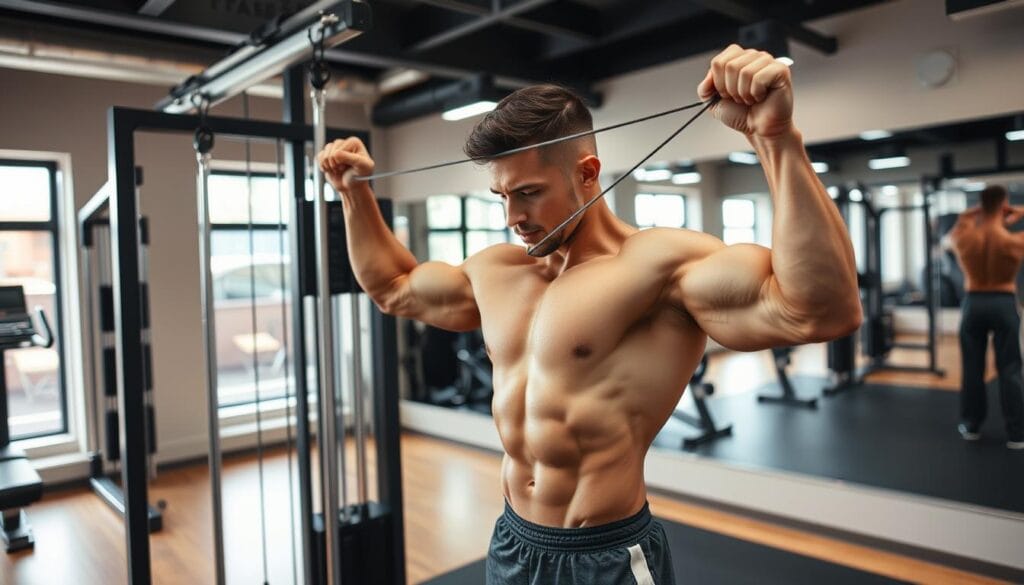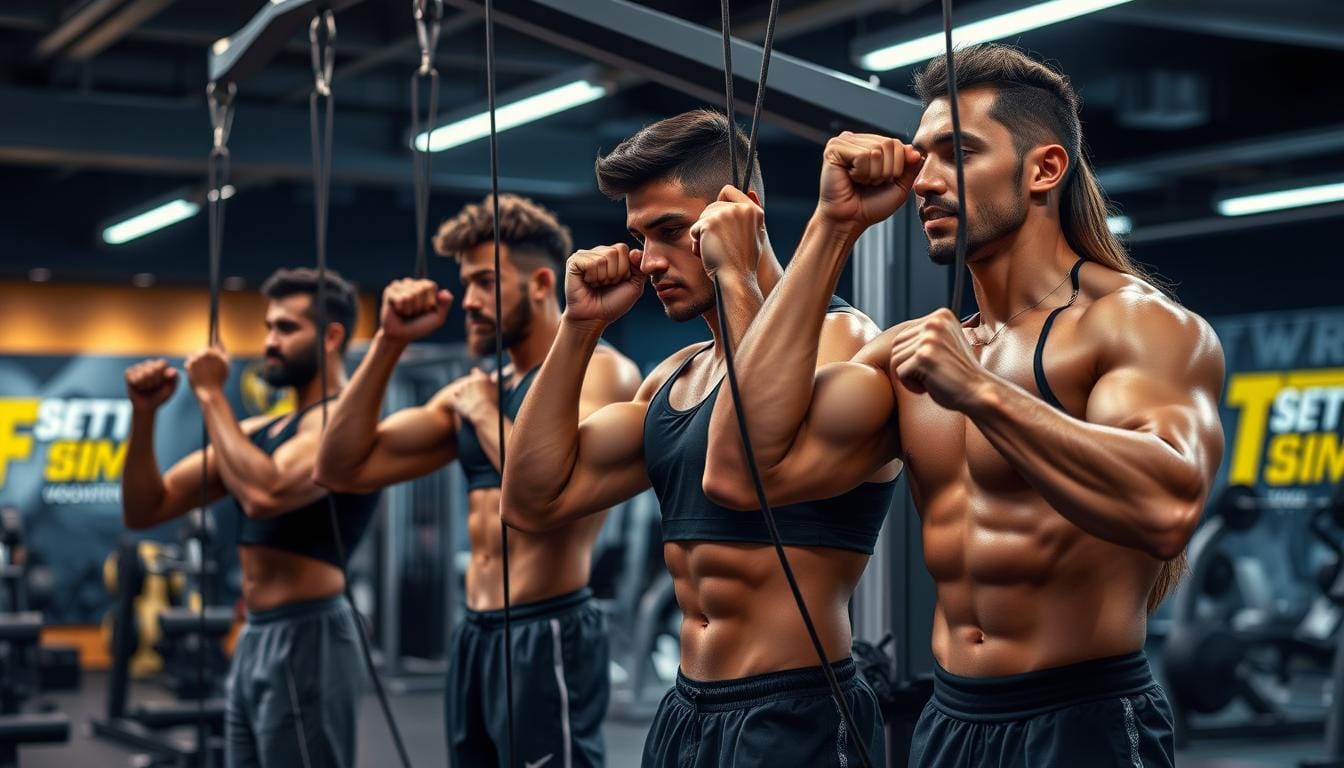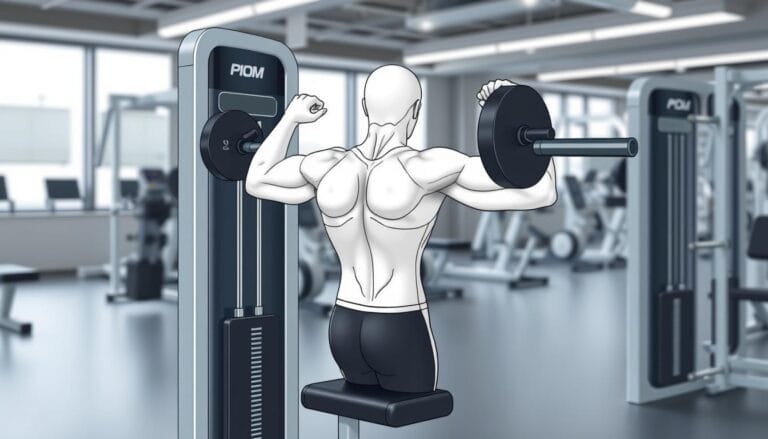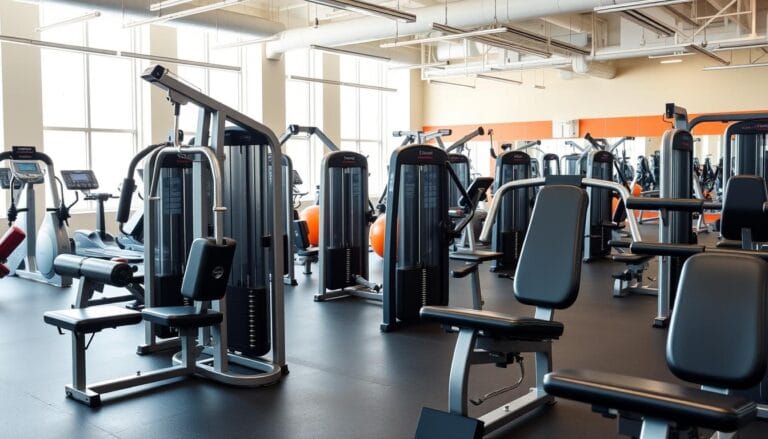Top 10 Cable Shoulder Exercises for Maximum Strength
My fitness journey hit a turning point with cable shoulder exercises. I had trouble defining my shoulder muscles and building strength. But cable machines changed everything for me.
Cable shoulder exercises are a game-changer for building muscle. They offer a unique way to work out that traditional weights can’t match. These exercises provide constant tension, focusing on your deltoids with great results. They’re perfect for anyone, whether you’re new to working out or have been doing it for years.
The deltoids are made up of three parts: anterior, lateral, and posterior. It’s important to target each part for full shoulder development. Cable machines make this easy and effective.
This guide will show you the best cable shoulder exercises. They’ll help you build strength, improve muscle definition, and avoid injuries. These exercises are more than just lifting weights. They help create a strong, balanced shoulder that supports your whole upper body.
Get ready to change your shoulder workout with cable exercises. You’ll see real results and have stronger, more defined shoulders in no time.
Table of Contents
Understanding Shoulder Muscle Anatomy and Function
Your shoulder muscles are complex and powerful. They allow for a wide range of motion. The deltoid muscle, key for cable shoulder exercises, has three heads. These heads work together to give strength and stability.
The shoulder complex is very intricate. It has four main joints for exceptional mobility. The glenohumeral joint has the largest range of motion. This makes it crucial for strength training.
Anterior Deltoid Function and Movement
The anterior deltoid is vital for shoulder function. It’s responsible for:
- Shoulder flexion
- Front arm lifting
- Pushing movements
- Stabilizing the shoulder during lateral raise exercises
Middle Deltoid Role in Shoulder Development
Your middle deltoid is key for lateral raise movements. It helps in developing shoulder width and muscle appearance. This muscle head enables:
- Arm abduction
- Shoulder width development
- Lateral movement capabilities
Posterior Deltoid Importance for Balance
The posterior deltoid ensures balanced shoulder development. It supports important movements like:
- Shoulder extension
- Rear arm lifting
- Rotational movements
“Understanding your shoulder anatomy is the first step to effective strength training.” – Sports Medicine Research
Knowing about these muscle groups helps you create better cable shoulder exercises. These exercises can engage muscles more and promote balanced development.
Benefits of Cable Machines for Shoulder Training
Cable shoulder exercises are a game-changer for building strong and defined shoulders. Unlike free weights, cable machines bring unique benefits to your workout. They can completely change how you train.
The main advantage of cable shoulder exercises is the constant tension they provide. This steady resistance helps engage your muscles fully, especially during front raises.
- Maintains continuous muscle activation
- Reduces risk of injury
- Allows precise muscle targeting
Cable machines make your shoulder workouts better because they’re so versatile. You can do many different exercises that regular equipment can’t. Adjusting height, angle, and resistance lets you challenge your muscles in new ways.
“Cable machines provide a controlled environment for developing shoulder strength and preventing potential injuries.” – Professional Fitness Trainer
Key benefits of cable shoulder exercises include:
- Enhanced joint stability
- Improved muscle definition
- Greater range of motion
- Smoother, more controlled movements
Whether you’re just starting out or are an advanced athlete, cable shoulder exercises are for everyone. They offer workouts that can be tailored to your level. This makes them a key tool for building strong shoulders.
Essential Equipment and Setup for Cable Shoulder Exercises
To get the most out of cable shoulder exercises, you need the right gear and setup. Cable machines are great for shoulders because they offer constant tension and a variety of movements. This is something free weights can’t do.
Cable Machine Types and Attachments
There are many types of cable machines for shoulder exercises:
- Functional trainers with multiple adjustable pulleys
- Compact cable machines for home gyms
- Wall-mounted cable stations
- Single-station cable units
Proper Setup and Safety Considerations
Getting your cable shoulder exercises set up right is key. First, adjust the pulley height to fit your movement. For reverse flys, set it at shoulder height or a bit higher. Start with light weights to learn the right form.
“Proper setup is the foundation of safe and effective cable shoulder exercises.”
Weight Selection Guidelines
Choosing the right weights is important for a good cable shoulder workout:
- Begin with 30-50% of your max weight
- Do controlled, smooth movements
- Keep tension constant during the exercise
- Slowly add more weight as you get better
Cable machines offer constant resistance. This means you’ll feel the muscles working all the way through the exercise. It’s perfect for building shoulder strength and muscle.
For reverse flys, aim for 8-12 reps per set. Do 3 sets to really work your posterior deltoids. The cable machine lets you change your grip, angle, and resistance. This keeps your muscles challenged.
Cable Shoulder Exercises for Maximum Results
Cable shoulder exercises are a game-changer for building strong, defined shoulders. Unlike free weights, cable machines offer constant tension. This can boost muscle strength by up to 25% in just 8 weeks.

Adding diverse cable exercises to your workout can greatly enhance shoulder development. These exercises target all three deltoid heads: anterior, lateral, and posterior. Each muscle group is vital for strong shoulders and overall strength.
- Anterior deltoid focuses on front shoulder movements
- Lateral deltoid contributes to shoulder width
- Posterior deltoid supports rear shoulder strength
The upright row is a standout cable exercise. It works multiple muscles well. Done right, it can boost muscle activation by up to 30%.
“Variety is the key to comprehensive shoulder development” – Strength Training Experts
Here’s a quick overview of recommended repetitions for key cable shoulder exercises:
| Exercise | Reps | Sets |
|---|---|---|
| Cable Front Raises | 8-12 | 3 |
| Cable Lateral Raises | 10 | 3 |
| Cable Face Pulls | 8-12 | 3 |
Pro tip: Always maintain proper form to maximize muscle engagement and minimize injury risk.
Targeting the Front Deltoids with Cable Movements
Strong front deltoids are key for good shoulder strength and sports performance. Cable exercises are great for targeting these muscles with precision and steady tension.
Knowing how the anterior deltoid works helps you create better workouts. These muscles are important for pressing and moving your shoulders up. So, it’s vital to train them well for muscle growth.
Cable Front Raises Technique
Getting good at cable front raises means paying attention to your form. Here are the main steps for the best results:
- Stand facing away from the cable machine
- Grasp the handle with a neutral grip
- Keep a slight bend in your elbow
- Raise the cable to shoulder height
- Maintain controlled, steady movement
Single-Arm Cable Press Variations
Single-arm cable presses are great for focusing on the front deltoids. They help fix muscle imbalances and boost shoulder stability.
“Unilateral training can dramatically improve muscle symmetry and prevent compensatory movements.” – Professional Strength Coach
Face Pull Execution Tips
Face pulls are a flexible cable exercise that works many muscles. They help build rear deltoids and improve your posture and shoulder health.
- Set cable at head height
- Use a rope attachment
- Pull handles toward your face
- Focus on external rotation
- Squeeze shoulder blades together
Do 3-4 sets of 8-12 reps for these cable exercises. Stick to proper form and keep practicing to build strong, defined front deltoids.
Building Boulder Shoulders with Lateral Movements
Cable shoulder exercises are key for wide shoulders. The lateral deltoids are crucial for that boulder shoulder look. By focusing on these muscles, you can boost your shoulder look and strength.

Lateral movements are vital for wider shoulders. Cable machines offer unique benefits for shoulder exercises. They keep muscles engaged with constant tension.
- Target the medial deltoids specifically
- Maintain consistent muscle tension
- Improve overall shoulder definition
“Developing broad shoulders requires precision and targeted cable shoulder exercises.”
When doing cable lateral raises, focus on form and control. Aim for 10 reps in 3 sets. Proper technique is more important than heavy weights.
| Exercise Type | Reps | Sets | Muscle Focus |
|---|---|---|---|
| Single-Arm Cable Lateral Raise | 10-12 | 3 | Lateral Deltoids |
| Dual-Arm Cable Lateral Raise | 8-12 | 3 | Medial Shoulder Muscles |
Advanced athletes can try seated cable lateral raises or single-arm movements. These add variety and prevent plateaus. Remember, regular training and correct technique are essential for boulder shoulders.
Posterior Deltoid Development Techniques
Your shoulder muscles need attention, especially the posterior deltoids. These muscles are key for upper body strength and balance. Working on your rear delts through cable exercises can change your look and performance.
It’s important to train your posterior deltoids for balanced shoulders. They help with 30% of arm movements and keep your shoulders stable.
Reverse Fly Form Guide
The rear delt fly is great for your posterior deltoids. Here’s how to do it right:
- Stand sideways to the cable machine
- Grab the cable handle with your outside hand
- Maintain a slight bend in your elbow
- Pull the cable across your body in a controlled motion
- Focus on squeezing your shoulder blade at the peak of the movement
Cable Pull Variations
Try different cable exercises to work your muscles from all sides. This boosts your posterior deltoid strength:
| Exercise | Muscle Activation | Difficulty Level |
|---|---|---|
| Face Pulls | 70% Posterior Deltoid | Intermediate |
| Cable High Rows | 65% Posterior Deltoid | Beginner |
| Standing Cable Rear Delt Fly | 75% Posterior Deltoid | Advanced |
Rear Deltoid Training Tips
Here are tips to improve your posterior deltoid training:
- Focus on form over heavy weights
- Do both isolation and compound exercises
- Train rear delts 2-3 times a week
- Use a full range of motion
- Gradually increase weight to avoid injury
“Balanced shoulder development is not just about aesthetics, but functional strength and injury prevention.” – Strength Training Specialist
By using these cable exercises and rear delt fly techniques, you’ll get stronger, more stable shoulders. They’ll look great and perform well.
Creating an Effective Cable Shoulder Workout Routine
Creating a good cable shoulder workout needs careful planning. It should target all three deltoid heads. This balance helps grow muscles and avoid getting stuck.
- Strength Training: Do 4-5 sets with 5-8 reps
- Muscle Hypertrophy: Aim for 3-4 sets with 8-12 reps
- Endurance Training: Do 2-3 sets with 15-20+ reps
- Power Training: Execute 3-5 sets with 3-6 reps
Your workout should include external rotation exercises. Start with big movements like cable overhead presses. Then, move to smaller exercises like lateral raises and face pulls.
“Variety is the key to continuous muscle growth and preventing workout monotony.”
Important things to remember for your routine are:
- Warm up well before starting intense exercises
- Keep the right form to work the muscles right
- Keep adding weight and complexity
- Give enough rest between shoulder workouts
Consistent effort and smart planning will make your shoulders stronger and more defined with cable machines.
Conclusion
Cable exercises can take your shoulder training to new heights. They offer unmatched muscle activation and strength growth. Studies show cable machines provide constant tension, leading to better muscle growth than free weights.
Adding battle rope exercises to your cable shoulder workouts makes your upper body training complete. Rope exercises boost muscle endurance and add dynamic movement. For beginners, battle ropes are a great way to enhance shoulder strength and stability.
Progressive overload is crucial for muscle growth. Cable machines keep tension constant, targeting your deltoids precisely. Focus on proper form to avoid injuries and achieve great shoulder development. Varying your exercises is key to balanced shoulder strength.
Consistent practice and smart exercise choices will change your shoulder training. Cable machines are safer and more controlled for building strong shoulders. Stay committed, and you’ll see your shoulder strength and definition improve dramatically.







